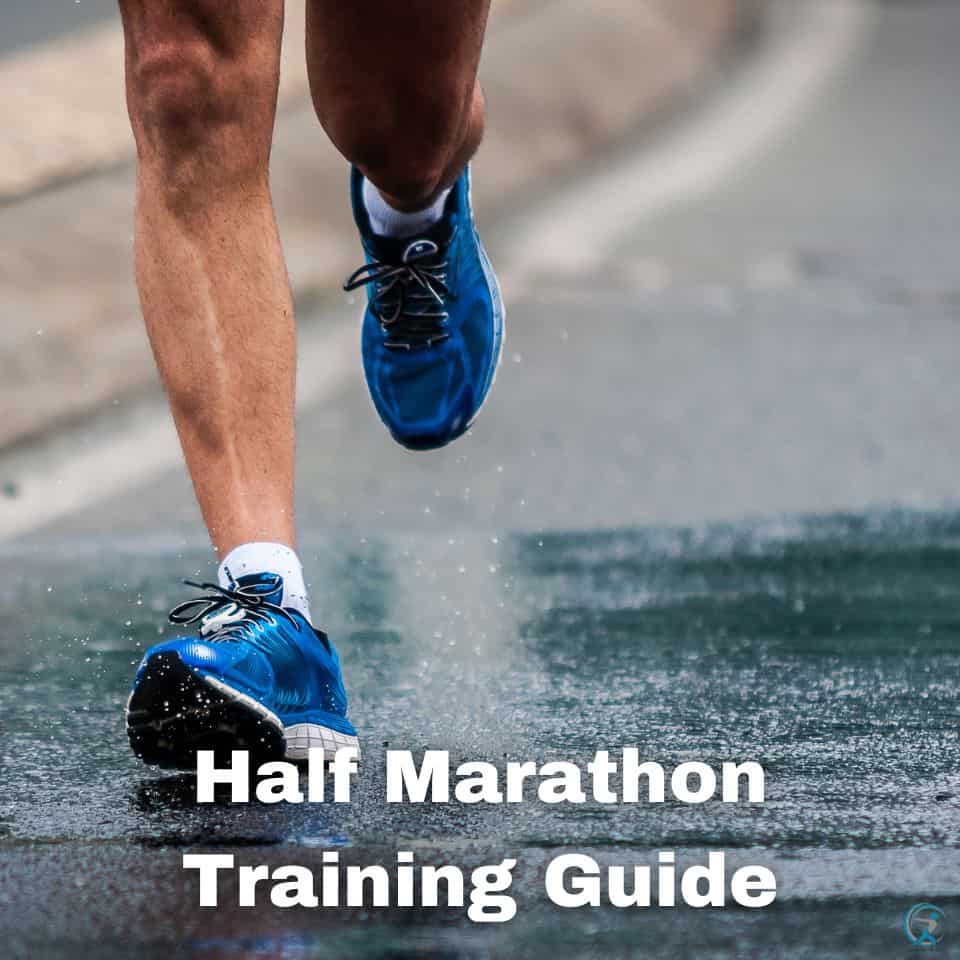The half marathon sits there — 13.1 miles of pavement waiting for your feet to pound across it. Not quite the full marathon beast, but no lightweight either. A distance that demands respect. People tackle these races every weekend, regular folks with jobs and kids and creaky knees, somehow finding time to train their bodies to cover a distance most would drive without thinking twice.
Training for a half marathon isn’t rocket science, but it isn’t a walk in the park either. It takes planning, patience, and a bit of stubbornness. The good news? Almost anyone can do it. The bad news? Almost anyone can do it badly and end up hurt or hating the whole thing.This guide cuts through the nonsense.
You want to run 13.1 miles? Here’s how to do it without breaking yourself in the process.

Key Takeaways
- Start with a solid base of 3-4 runs per week before beginning half marathon-specific training
- Most training plans last 12-16 weeks, with gradual increases in weekly mileage
- Long runs are the cornerstone of training, building from 4-5 miles to 10-12 miles
- Proper nutrition and hydration significantly impact training quality and race performance
- Recovery is as important as the running itself — neglect it at your peril
- Mental preparation techniques help overcome the inevitable tough patches during training and racing
What Is a Half Marathon?
A half marathon spans 13.1 miles (21.1 kilometers). Not quite the full marathon’s 26.2 miles, but long enough to test your limits and short enough to not completely destroy your body. It’s the sweet spot of distance running — challenging but accessible.
The popularity of half marathons has exploded in recent years. More runners sign up for half marathons than full marathons, and the reasons make sense: training doesn’t consume your entire life, recovery happens faster, and the sense of achievement remains substantial.
Who Can Train for a Half Marathon?

Almost anyone with basic fitness can train for a half marathon. You don’t need to be some natural-born runner with gazelle genes. Regular people — teachers, accountants, nurses, parents with minivans — make up most half marathon fields.
That said, check with your doctor first if you have health concerns. Heart issues, joint problems, or other medical conditions might require modifications to standard training approaches.
If you’re brand new to running, give yourself time to build a base before jumping into half marathon training. Running for seniors may require additional considerations, but age alone isn’t a barrier.
Building Your Training Foundation

Before diving into half marathon-specific training, establish a base of regular running. Aim for:
- 3-4 running days per week
- Ability to run continuously for 30 minutes
- Weekly mileage of 10-15 miles
- At least 2-3 months of consistent running
Without this foundation, jumping into half marathon training risks injury and frustration. Running places significant stress on your body — bones, muscles, tendons, and joints need time to adapt.
“The biggest mistake new half marathoners make is rushing the process,” says most running coaches worth their salt. Your body strengthens during recovery, not during running itself. Breathing techniques while running can help make your foundation training more effective.
The Essential Components of Half Marathon Training
The Long Run
The long run forms the backbone of half marathon training. Each week, you’ll do one run longer than all others, gradually increasing distance until you can handle 10-12 miles comfortably.Long runs build:
- Endurance
- Mental toughness
- Fat-burning efficiency
- Running economy
Start with whatever “long” means to you now — maybe 4 miles — and add approximately 1 mile every 1-2 weeks. Keep the pace conversation-friendly. If you’re gasping for breath, you’re going too fast.
Weekday Runs
Between long runs, shorter weekday runs maintain fitness and build volume. A typical week might include:
- 1-2 easy recovery runs (30-45 minutes at comfortable pace)
- 1 tempo run or speed workout (challenging but controlled effort)
- 1 long run (gradually increasing distance)
- 2-3 rest or cross-training days
Total weekly mileage should increase gradually, usually by no more than 10% each week.
Cross-Training and Strength Work
Smart half marathon training isn’t just running. Cardio and strength training work together to build a resilient runner’s body. Add 1-2 days of:
- Strength training (focus on core, hips, glutes)
- Cross-training (swimming, cycling, elliptical)
- Yoga or mobility work
These activities improve overall fitness while giving running muscles a break. They build strength that prevents injuries and improves running efficiency.
Sample 12-Week Half Marathon Training Plan

This plan assumes you can already run 4 miles comfortably:
Week 1-4: Building Phase
- Monday: Rest or cross-train
- Tuesday: 3-4 miles easy
- Wednesday: 4-5 miles with middle miles at tempo pace
- Thursday: Rest or cross-train
- Friday: 3 miles easy
- Saturday: Rest
- Sunday: Long run (5, 6, 7, 8 miles)
Week 5-8: Development Phase
- Monday: Rest or cross-train
- Tuesday: 4-5 miles with hill repeats
- Wednesday: 5-6 miles at easy pace
- Thursday: 4-5 miles with intervals or tempo sections
- Friday: Rest
- Saturday: 3-4 miles easy
- Sunday: Long run (9, 10, 10, 11 miles)
Week 9-12: Peak and Taper Phase
- Monday: Rest or cross-train
- Tuesday: 5 miles with speed work
- Wednesday: 5-6 miles easy
- Thursday: 4-5 miles easy
- Friday: Rest
- Saturday: 3 miles with race pace sections
- Sunday: Long run (12, 12, 10, RACE)
Adjust this plan to your fitness level and schedule. The key principles remain the same: progressive long runs, varied pace workouts, and adequate recovery.
Nutrition and Hydration

Your body runs on what you put into it. Half marathon training increases nutritional needs, especially for carbohydrates and protein.
Daily Nutrition
Focus on whole foods that provide sustained energy:
- Complex carbohydrates (oats, sweet potatoes, whole grains)
- Lean protein (chicken, fish, tofu, beans)
- Healthy fats (avocados, nuts, olive oil)
- Abundant fruits and vegetables
The essential guide to nutrition for fitness training provides more detailed information on daily food choices for active individuals.
Pre-Run Fueling
Before shorter runs (under 60 minutes), a small snack with easily digestible carbs works well:
- Half a banana
- Toast with honey
- Small handful of dry cereal
For long runs, eat a more substantial meal 2-3 hours before:
- Oatmeal with banana and honey
- Toast with peanut butter and jam
- Yogurt with granola and fruit
During-Run Nutrition
For runs under 90 minutes, water usually suffices. Beyond that, consider:
- Sports drinks (for electrolytes and quick carbs)
- Energy gels or chews (30-45 minutes apart)
- Easy-to-carry real foods (dates, pretzels)
Practice your race-day nutrition strategy during training. Your stomach needs training just like your legs.
Hydration Strategies
Proper hydration starts before your run and continues after. Some guidelines:
- Drink water consistently throughout the day
- Consume 16-20 oz of fluid 2-3 hours before running
- During runs over 60 minutes, drink 4-8 oz every 15-20 minutes
- After running, replace lost fluids gradually
Nutrition and hydration in running performance offers more detailed strategies for optimizing your fluid intake.
Recovery and Injury Prevention
Half marathon training breaks your body down. Recovery builds it back stronger. Neglect recovery and watch your progress stall or, worse, reverse with injury.
Post-Run Recovery
Immediately after running, especially long or hard efforts:
- Rehydrate with water and electrolytes
- Consume protein and carbs within 30-60 minutes
- Perform gentle stretching
- Use foam rollers or massage tools for tight spots
How to recover from workouts provides excellent strategies to maximize this critical phase of training.
Rest Days
Rest days aren’t wasted training days—they’re when adaptation happens. Use them wisely:
- Complete rest (sometimes doing nothing is doing something)
- Active recovery (gentle walking, swimming, yoga)
- Extra sleep (aim for 7-9 hours nightly)
- Stress reduction (meditation, nature time)
Common Injuries and Prevention
Watch for these frequent half marathon training injuries:
- Runner’s knee (patellofemoral pain)
- IT band syndrome
- Shin splints
- Plantar fasciitis
- Achilles tendonitis
Prevent problems with:
- Proper running shoes (replace every 300-500 miles)
- Gradual mileage increases (the 10% rule)
- Strength training for supporting muscles
- Running form awareness and improvements
- Listening to your body’s warning signs
How to avoid injuries while working out offers additional prevention strategies.
Mental Preparation
Half marathon training tests your mind as much as your body. Physical training without mental preparation leaves you vulnerable when things get tough.
Training Your Brain
Develop mental toughness through:
- Visualization (imagine successful runs and races)
- Positive self-talk (“I am strong” beats “This hurts”)
- Chunking (break the race into manageable segments)
- Presence (focus on current mile, not miles remaining)
- Mantra development (short phrases to repeat when struggling)
The benefits of running a mile a day can help establish the mental discipline needed for longer training.
Race Day Strategy
All that training comes down to race day. Don’t blow months of work with rookie mistakes:
The Week Before
- Reduce training volume (but maintain some intensity)
- Hydrate consistently
- Increase carbohydrate intake slightly
- Check all gear and logistics
- Review the course map and elevation profile
Race Morning
- Wake early enough for proper fueling (2-3 hours pre-race)
- Eat familiar foods—nothing new!
- Arrive with ample time for parking, bathroom, warm-up
- Do a short warm-up jog and dynamic stretches
- Line up in appropriate pace group
Race Execution
- Start slower than you think you should
- Break the race into 3-mile segments
- Use aid stations strategically
- Maintain consistent effort on hills (effort, not pace)
- Save something for the final 5K
Trail running races require slightly different strategies than road half marathons, so adjust accordingly if you’re going off-road.
After Your Half Marathon
Congratulations—you did it! But the work isn’t quite done:
Immediate Recovery
- Keep moving after crossing the finish line (prevent blood pooling)
- Hydrate and refuel promptly
- Wear warm, dry clothes
- Celebrate—you earned it!
The Week After
- Take 3-7 days off from running
- Try gentle cross-training after 2-3 days
- Get extra sleep
- Reflect on your experience and what you learned
What’s Next?
After complete recovery (usually 2-3 weeks), consider:
- Another half marathon (to improve your time)
- A different distance challenge
- A training cycle focused on speed
- A well-deserved break from structured training
The importance of recovery in maximizing your running performance provides guidance on how to navigate this crucial transition.
Gear Essentials for Half Marathon Training

You don’t need much to start, but certain items make training more comfortable and effective:
Must-Haves
- Properly fitted running shoes from a specialty store
- Moisture-wicking socks
- Technical fabric running clothes
- Weather-appropriate gear (hat, gloves, layers)
- Water bottle or hydration system
Nice-to-Haves
- GPS watch or running app
- Foam roller and massage tools
- Anti-chafing products
- Nutrition storage solutions (belt, vest, handheld)
- Reflective gear for visibility
Best running shoes for women and similar guides can help you choose appropriate footwear for your specific needs.
Benefits of Half Marathon Training

| Benefit | Description | Evidence/Study Reference |
|---|---|---|
| Improved cardiovascular health | Regular endurance training strengthens the heart and improves blood circulation. | ACSM Guidelines for Exercise Testing and Prescription, 10th Edition |
| Weight loss and management | Endurance training and regular physical activity can lead to a healthier life. | Medicine and Science in Sports and Exercise, 2012 |
| Increased muscle strength | Training for a half marathon improves leg strength, including the quadriceps, hamstrings, and calves. | Journal of Strength and Conditioning Research, 2015 |
| Enhanced mental health | Endurance training has been shown to reduce stress, anxiety, and depression. | American Journal of Preventive Medicine, 2016 |
| Improved endurance | Regular long-distance running builds stamina, allowing for longer periods of physical activity. | Journal of Applied Physiology, 2014 |
| Reduced risk of chronic diseases | Half marathon training can help lower the risk of type 2 diabetes, heart disease, and stroke. | American Journal of Epidemiology, 2013 |
| Social connections | Joining a running group or participating in organized races fosters a sense of community and belonging. | Journal of Sports Sciences, 2018 |
| Goal setting and achievement | Training for a half marathon provides a measurable goal that helps to build self-confidence and a sense of accomplishment. | Psychology of Sport and Exercise, 2017 |
| Improved sleep quality | Social Connections | Sleep Medicine Reviews, 2017 |
| Increased longevity | Regular exercise, including half-marathon training, has been linked to better sleep quality. | British Journal of Sports Medicine, 2015 |
Half Marathon Plan
Half Marathon Plan (12-Week Beginner Training Schedule)
| Week | Monday | Tuesday | Wednesday | Thursday | Friday | Saturday | Sunday |
|---|---|---|---|---|---|---|---|
| 1 | Rest | 3 miles | 2 miles | 3 miles | Rest | 4 miles | Cross-Training |
| 2 | Rest | 3 miles | 2 miles | 3 miles | Rest | 5 miles | Cross-Training |
| 3 | Rest | 4 miles | 3 miles | 4 miles | Rest | 6 miles | Cross-Training |
| 4 | Rest | 4 miles | 3 miles | 4 miles | Rest | 8 miles | Cross-Training |
| 5 | Rest | 5 miles | 4 miles | 5 miles | Rest | 10 miles | Cross-Training |
| 6 | Rest | 5 miles | 4 miles | 5 miles | Rest | 12 miles | Cross-Training |
| 7 | Rest | 6 miles | 5 miles | 6 miles | Rest | 10 miles | Cross-Training |
| 8 | Rest | 6 miles | 5 miles | 6 miles | Rest | 12 miles | Cross-Training |
| 9 | Rest | 7 miles | 6 miles | 7 miles | Rest | 14 miles | Cross-Training |
| 10 | Rest | 7 miles | 6 miles | 7 miles | Rest | 16 miles | Cross-Training |
| 11 | Rest | 8 miles | 6 miles | 8 miles | Rest | 12 miles | Cross-Training |
| 12 | Rest | 5 miles | 4 miles | 5 miles | Rest | Half Marathon | Rest |
- Cross-Training includes activities such as cycling, swimming, yoga, or strength training that help to balance the muscle groups used in running and prevent injury. Aim for 30-45 minutes per session.
- This plan is for beginner runners who can comfortably run 3 miles. It is essential to consult with a healthcare professional before beginning any training program.
- Adjust the plan as needed to fit your individual fitness level and schedule. Listening to your body and avoiding overtraining or pushing too hard is essential.
Tips for Success in Half Marathon Training

| Tip | Description | Example |
|---|---|---|
| Set realistic goals | Perform dynamic and static stretches for 5-10 minutes before a run afterward. | Target a finish time, personal best, or completing the race without walking. |
| Follow a tailored training plan | Choose a plan that suits your experience, schedule, and objectives. | Select a beginner, intermediate, or advanced 12-week plan. |
| Listen to your body | Pay attention to physical cues and adjust training to avoid overtraining or injury. | Take extra rest days or reduce mileage if needed. |
| Vary workouts | Incorporate diverse workouts, such as speedwork, hill training, and cross-training. | Include interval training, tempo runs, and strength training in your schedule. |
| Prioritize rest and recovery | Schedule rest days and ensure adequate sleep to support optimal performance. | Allocate 1-2 rest days per week and aim for 7-9 hours of sleep per night. |
| Focus on nutrition and hydration | Fuel your body with proper nutrients and stay hydrated before, during, and after training. | Consume a balanced diet, drink water consistently, and practice race-day fueling. |
| Gradually increase mileage | Build running mileage slowly and consistently to reduce injury risk and promote adaptation. | Follow the 10% rule for weekly mileage increases. |
| Warm-up and cool-down | Use warm-up and cool-down routines to enhance performance and reduce injury risk. | Perform dynamic stretches before a run and static stretches afterward for 5-10 minutes. |
| Find a running community | Connect with other runners or join a club for support and motivation. | Look for local running clubs, group runs, or online communities. |
| Embrace mental training | Develop mental strategies to cope with half marathon challenges. | Use visualization, positive self-talk, and mindfulness techniques to improve resilience. |
Conclusion
Half marathon training isn’t complicated, but it demands consistency and respect for the process. The 13.1-mile distance reveals what you’re made of—both physically and mentally.
Follow a structured plan that matches your experience level. Build gradually. Recover properly. Fuel smartly. Train your mind alongside your body. On race day, trust your training and embrace the challenge.
The finish line waits for anyone willing to put in the work to reach it. Maybe that’s you.
References:
[1] https://www.nike.com/running/half-marathon-training-plan
[2] https://run.outsideonline.com/training/training-plans/half-marathon/couch-to-half-marathon-training-plan-2/
[3] https://runtothefinish.com/couch-half-marathon/
[4] https://www.runnersworld.com/training/a20843627/half-marathon-training-for-beginners/
[5] https://www.halhigdon.com/training-programs/half-marathon-training/novice-1-half-marathon/
[6] https://www.childrenscolorado.org/conditions-and-advice/sports-articles/sports-injuries/half-marathon-training-tips/
[7] https://www.mymottiv.com/half-marathon-training-plan/half-marathon-training-plan-with-strength-training
[8] https://support.runna.com/en/articles/6186865-the-ultimate-half-marathon-training-guide
[9] https://stories.strava.com/articles/how-to-train-for-a-half-marathon
[10] https://highfive.co.uk/blogs/guides/half-marathon-training-plan
[11] https://www.runnersworld.com/uk/training/half-marathon/a25887045/beginner-half-marathon-training-schedule/
[12] https://www.reddit.com/r/XXRunning/comments/1dkdwom/favorite_half_marathon_training_plans/
[13] https://www.rei.com/learn/expert-advice/how-to-run-half-marathon.html
[14] https://www.halhigdon.com/training/half-marathon-training/
[15] https://www.befitrunners.com/the-ultimate-half-marathon-training-guide-for-beginners
[16] https://marathonhandbook.com/trainingplans/half-marathon-training-plans/
As a veteran fitness technology innovator and the founder of GearUpToFit.com, Alex Papaioannou stands at the intersection of health science and artificial intelligence. With over a decade of specialized experience in digital wellness solutions, he’s transforming how people approach their fitness journey through data-driven methodologies.

